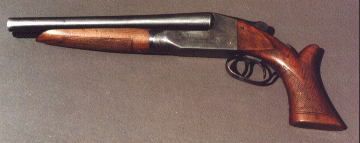By the Author of the Scrapboard : | |
|---|---|
 | Attack, Avoid, Survive: Essential Principles of Self Defence Available in Handy A5 and US Trade Formats. |
 | |
 | Crash Combat Second Edition with additional content. Epub edition Second Edition with additional content. Crash Combat Third Edition Epub edition Third Edition. |
 | |
 | |
 Most sawn-offs have been created by taking a conventional double-barreled gun and chopping the barrels and usually most of the stock too. There have been a few purpose designed guns. In the 1920s Ithaca produced the Auto & Burglar gun (left) with 10” barrels (some models had 12¼”), 16” loa and a weight of around 4.5 lb (this source quotes a contemporary advertisment that claims 1¼lb). Grip resembled that of a revolver but on the early models had a comb or spur like projection designed to spread recoil forces into the hand. Some models had barrels of 12.5”. Similar was Holland's Auto-Burglar gun and Defiance's “Anti-Bandit”. All of these were 20 gauge in either 2 ¾ or 3” chambering. A French company makes a 12 bore OU pistol, the GC54. This is mainly used with riot rounds such as CS cloud and rubber shot.
Most sawn-offs have been created by taking a conventional double-barreled gun and chopping the barrels and usually most of the stock too. There have been a few purpose designed guns. In the 1920s Ithaca produced the Auto & Burglar gun (left) with 10” barrels (some models had 12¼”), 16” loa and a weight of around 4.5 lb (this source quotes a contemporary advertisment that claims 1¼lb). Grip resembled that of a revolver but on the early models had a comb or spur like projection designed to spread recoil forces into the hand. Some models had barrels of 12.5”. Similar was Holland's Auto-Burglar gun and Defiance's “Anti-Bandit”. All of these were 20 gauge in either 2 ¾ or 3” chambering. A French company makes a 12 bore OU pistol, the GC54. This is mainly used with riot rounds such as CS cloud and rubber shot.